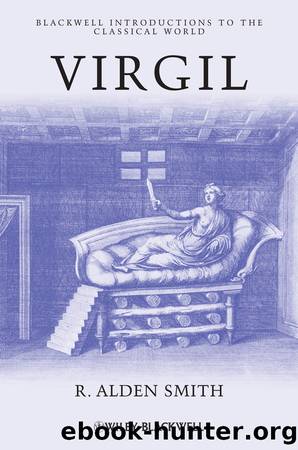Virgil by Smith R. Alden;

Author:Smith, R. Alden;
Language: eng
Format: epub
Publisher: John Wiley & Sons, Incorporated
Published: 2011-06-20T00:00:00+00:00
Conclusion: Recapitulation, Regeneration and Repast
In his description of the beesâ regeneration, Virgil cleverly recapitulates the major themes of each Georgic, themes that, taken together, point toward a repast of wisdom for the reader. This description begins when Aristaeus returns to the grove, where he finds a portent:
He comes to the shrine and he raises the altars in the manner that had been explained, leading four outstanding bulls with excellent form and as many heifers with necks untouched by the yoke. Afterward, when Aurora had brought on her ninth rising, he renders Orpheus funeral offerings and returns to the grove. But here they see a portent, sudden, and amazing in the telling: through the rotting internal organs of the cows, bees buzz within the whole belly and teem out from the broken ribs. They are drawn together in immense clouds and from the tree top they now commingle, hanging from pliant boughs as a cluster of grapes. (4.549â58)
This âportentâ accords with result of the bougonia, the regeneration of the hive which would have been a procedure known by Virgilâs readers. This regenerative phenomenon was as ancient as the story of Samsonâ s riddle in the Old Testament book of Judges. Virgilâs words are as riddling in their own right: he presents four lines of instruction (296â97), where four windows are to face the four winds, a description that, Thomas suggests, may hark back to the pre-Socratic atomistic philosopher Democritus. Further, these windows permit a view back from the four books of the Georgics to Virgilâs immediate didactic predecessor, Lucretius, whose poem had ended with death; through Virgil â s âwindowâ reference, he continues the didactic legacy, enhancing it by having the final book end with not death but regeneration.
The bougoniaâs theme of regeneration offers a partial and still indirect answer to the indirect questions of the first GeorgiCs prologue: for the immortal race of bees, life must necessarily return. To lead up to such regeneration, Virgil has used four books, paralleled by the four sacrifices or the four windows of the structure for the bougonia that introduced the story of Aristaeus. Out of the toxic rotting flesh of book 3 comes a reinstatement of the life of bees, whose civilization resonates at least in some ways with that of Rome. Yet any optimistic reading of this regeneration, such as that advanced by Bovie many years ago, is qualified by the poemâ s darker moments, and a tight comparison of the bee community with Rome must not be pressed too hard.16
Virgilâs structural nexus, if complicated, does much more than merely give the work coherency. The first half of the Georgics had been about plants, the second half about animals. The first half had celebrated bread and wine, the second half meat and honey. Taken together, these are the components of a Roman meal. Yet the food that Virgil wants to put before his reader is not merely a dinner such as the old Corycianâs simple fare, the bounteous winter festivities of the farmer and his wife (1.
Download
This site does not store any files on its server. We only index and link to content provided by other sites. Please contact the content providers to delete copyright contents if any and email us, we'll remove relevant links or contents immediately.
The Power of Myth by Joseph Campbell & Bill Moyers(925)
Half Moon Bay by Jonathan Kellerman & Jesse Kellerman(908)
A Social History of the Media by Peter Burke & Peter Burke(879)
Inseparable by Emma Donoghue(844)
The Nets of Modernism: Henry James, Virginia Woolf, James Joyce, and Sigmund Freud by Maud Ellmann(738)
The Spike by Mark Humphries;(719)
The Complete Correspondence 1928-1940 by Theodor W. Adorno & Walter Benjamin(703)
A Theory of Narrative Drawing by Simon Grennan(703)
Ideology by Eagleton Terry;(655)
Bodies from the Library 3 by Tony Medawar(647)
World Philology by(645)
Culture by Terry Eagleton(642)
Farnsworth's Classical English Rhetoric by Ward Farnsworth(641)
A Reader’s Companion to J. D. Salinger’s The Catcher in the Rye by Peter Beidler(612)
Adam Smith by Jonathan Conlin(605)
Game of Thrones and Philosophy by William Irwin(592)
High Albania by M. Edith Durham(589)
Comic Genius: Portraits of Funny People by(581)
Monkey King by Wu Cheng'en(575)
